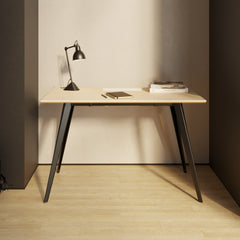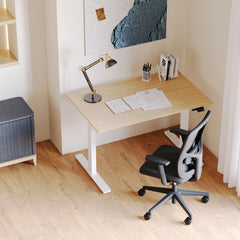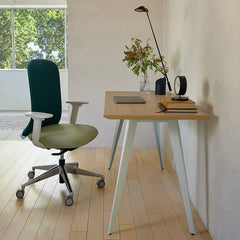Get 10% off your first order
Find the office furniture that’s designed to match your style, comfort, and needs perfectly. Subscribe
How Smart Furniture Choices Shape the Way You Work

Visit quiz page to see how we makes it easy to create an inspiring workplace


In a hybrid work world, boundaries can easily blur. The home blends into the office, and the office follows us home. What was once flexible can quickly become draining when the environment doesn’t support rest, structure, and rhythm.
An intentional workspace—one created with comfort, clarity, and purpose—helps protect your energy. It reminds you when it’s time to focus and when to step away. Let’s explore how design, layout, and mindful choices can help you work smarter without burning out.
Working between home and office may feel freeing at first, but without structure, it’s easy to overextend. Constant switching between environments keeps the brain in a state of alert.
Lack of separation between personal and work time
Poor lighting or posture at makeshift workstations
Digital fatigue from constant connectivity
Limited cues to begin or end the workday
An intentional workspace helps you define when work starts and stops—without guilt.
The desk is where structure begins. The Small Standing Desk Wyoming combines flexibility and simplicity, encouraging movement while keeping your space visually calm.
|
Feature |
Purpose |
Benefit |
|
Adjustable height |
Supports motion |
Reduces fatigue |
|
Compact layout |
Prevents clutter |
Enhances focus |
|
Neutral tones |
Calms the eye |
Promotes clarity |
|
Clean lines |
Simplifies space |
Improves flow |
When your desk feels balanced, your mind naturally follows.
Physical movement refreshes mental energy. A standing desk encourages circulation and helps prevent stiffness, one of the biggest contributors to fatigue.
Alternate sitting and standing every 45–60 minutes.
Stretch your arms, neck, and shoulders during breaks.
Walk for five minutes between calls.
Keep posture upright and relaxed.
Movement builds endurance and balance, allowing energy to last longer through the day.
Lighting affects mood, attention, and productivity. Poor lighting strains the eyes and reduces alertness.
Use natural light whenever possible.
Choose warm or neutral bulbs for balance.
Avoid glare from overhead lighting.
Position your desk near a window for both daylight and perspective.
Balanced lighting signals to your body that it’s time to focus—and later, to rest.
Discomfort drains energy. Proper support sustains both posture and peace of mind. A modern office desk paired with a supportive chair helps maintain comfort during long work sessions.
|
Element |
Adjustment |
Effect |
|
Chair height |
Align knees at 90° |
Reduces strain |
|
Monitor position |
Eye-level view |
Prevents neck tension |
|
Arm support |
Adjustable angle |
Relieves wrist fatigue |
|
Foot placement |
Flat on floor |
Promotes circulation |
Small ergonomic shifts can significantly impact how your body and mind sustain energy throughout the day.
A workspace should remind you when to work—and when to rest. Simple visual cues help reinforce mental transitions.
Use a desk lamp as your “on” and “off” switch.
Keep a plant as a visual signal for grounding.
Close your laptop at the same time daily.
Use scent (like lavender or citrus) to refresh energy.
Consistency strengthens focus and protects boundaries.

A cluttered environment quietly competes for attention. Keep surfaces minimal to reduce distractions and promote calm.
Assign every item a home.
Use vertical storage to free desk space.
Sort items weekly to maintain order.
Limit decorative objects to two or three meaningful pieces.
Order helps restore focus and makes the workspace easier to return to every day.
Nature’s Role in Stress Recovery
Natural elements improve emotional recovery and focus. Studies show that even small touches of greenery or wood tones can lower stress.
Add a low-maintenance plant near your monitor.
Choose wood-textured accessories for organic warmth.
Let in fresh air throughout the day.
Play soft natural sounds to enhance calm.
Nature creates softness in spaces built around screens and structure.
Research from the University of Washington’s ergonomics guide highlights how proper posture and workspace adjustments can significantly reduce physical strain while improving focus and comfort throughout the workday.
Good posture supports cognitive alertness.
Ergonomic furniture lowers physical stress.
Regular breaks improve decision-making.
Lighting and airflow affect comfort perception.
A workspace built for your body is one that helps your mind recover faster.
Some accessories make daily work feel effortless. An ergonomic arm accessory supports comfort while keeping your space minimal and functional.
|
Tool |
Purpose |
Benefit |
|
Wrist rest |
Reduces tension |
Prevents repetitive strain |
|
Adjustable armrest |
Promotes alignment |
Improves comfort |
|
Compact keyboard |
Saves space |
Keeps wrists straight |
|
Monitor stand |
Raises display |
Prevents eye strain |
Intentional tools create ease without cluttering your environment.
The space you work in should evolve with your schedule. Hybrid work thrives when supported by flexible environments that nurture balance.
Begin your day in natural light.
Schedule real breaks away from your screen.
Transition between work and home with short rituals.
Reset your desk at the end of the day.
A flexible mindset paired with a structured environment prevents burnout from creeping in quietly.
Color shapes emotional response. In hybrid setups, it helps separate work from rest without physical walls. Calm tones anchor focus, while natural hues soften stress.
|
Color |
Emotion |
Effect |
|
Warm beige |
Comfort |
Soothes overstimulation |
|
Sage green |
Balance |
Connects to nature |
|
Muted blue |
Clarity |
Calms visual tension |
|
Soft gray |
Neutrality |
Grounds busy layouts |
Subtle tones act like pauses for your mind—helping you stay steady in both creative and focused modes.
When work and life blend, rituals mark the boundary. Small routines signal the mind to focus or unwind.
Light a candle or open blinds to begin work.
Start your day with three slow breaths at your desk.
Step away for lunch in a different area.
Close your laptop and tidy the desk at day’s end.
These moments bring rhythm and intention, reducing the invisible fatigue that builds from constant availability.
Hybrid work will continue to evolve, and so should the spaces we create. A flexible setup with modular furniture, like adjustable desks and movable chairs, ensures your environment can grow with your needs.
Reconfigure layout monthly to refresh perspective.
Keep mobile pieces for collaboration or solitude.
Use soft dividers or rugs to define zones.
Reassess lighting and posture tools quarterly.
Workspaces that adapt are the antidote to stagnation—they evolve with your mindset, not against it.

Preventing burnout isn’t about doing less—it’s about creating spaces that sustain you. An intentional workspace nurtures your focus while reminding you that rest and balance are part of productivity.
Every element should serve comfort or clarity.
Boundaries create freedom, not limits.
Calm fuels creativity.
A workspace with purpose restores your energy.
A space that supports you is more than functional—it’s restorative. In hybrid work, where days blend and hours stretch, calm design keeps work meaningful instead of exhausting.

How Smart Furniture Choices Shape the Way You Work

The Beauty of Order: Desk Designs That Inspire Clarity

Design Choices That Bring Calm to Your Workspace
Get 10% off your first order
Find the office furniture that’s designed to match your style, comfort, and needs perfectly. Subscribe
Leave a comment